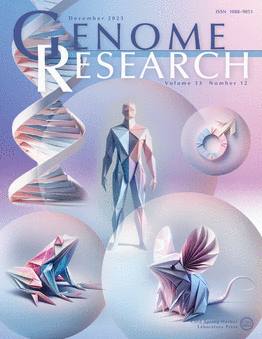中国白松露基因组的高质量组装和重新校准的分化时间估计提供了对结核科进化动力学的深入了解
IF 5.5
2区 生物学
Q1 BIOCHEMISTRY & MOLECULAR BIOLOGY
引用次数: 0
摘要
块菌属(科:块菌科)包括最有经济价值的外生菌根(ECM),块菌形成真菌。先前的基因组分析表明,大量转座因子(TE)增殖是ECM真菌(包括Tuberaceae)的一个趋同的基因组特征。重复序列构成了基因组进化的主要驱动力,塑造了其结构和调控网络。在此背景下,Tuberaceae可以成为研究其基因组影响的重要模型系统;然而,该家族缺乏高质量的组件。在这里,我们通过对濒临灭绝的中国白松露攀枝花进行高度连续的组装,以及重新校准的结核科多样化时间线和全面的比较基因组分析,来研究TEs与结核科基因组进化之间的相互作用。我们发现,与家族的古近纪多样化同时,已有的与chromoviridae相关的吉普赛分支在不同的松露谱系中独立扩展,导致基因组大小增加和高基因家族周转率,但没有导致高度重排的基因组。此外,我们发现了由祖先重复事件引起的ecm诱导的基因家族的显著富集。最后,我们首次在进化枝中探索了核糖体DNA (rDNA)位点的重复结构。大多数45S rDNA同源物正在经历协同进化,尽管一个孤立的分化位点引起了人们对元条形码和生物多样性评估的潜在问题的担忧。我们的研究为未来松露基因组学的研究建立了基础的基因组资源,并展示了一个清楚的例子,即异染色质的建立和自我延续扩张如何由于自私遗传元件的活动而驱动大量基因组大小的变化。本文章由计算机程序翻译,如有差异,请以英文原文为准。
High-quality assembly of the Chinese white truffle genome and recalibrated divergence time estimate provide insight into the evolutionary dynamics of Tuberaceae
The genus Tuber (family: Tuberaceae) includes the most economically valuable ectomycorrhizal (ECM), truffle-forming fungi. Previous genomic analyses revealed that massive transposable element (TE) proliferation represents a convergent genomic feature of ECM fungi, including Tuberaceae. Repetitive sequences constitute a principal driver of genome evolution shaping its architecture and regulatory networks. In this context, Tuberaceae can become an important model system to study their genomic impact; however, the family lacks high-quality assemblies. Here, we investigate the interplay between TEs and Tuberaceae genome evolution by producing a highly contiguous assembly for the endangered Chinese white truffle Tuber panzhihuanense, along with a recalibrated timeline for Tuberaceae diversification and comprehensive comparative genomic analyses. We find that, concurrently with a Paleogene diversification of the family, pre-existing Chromoviridae-related Gypsy clades independently expanded in different truffle lineages, leading to increased genome size and high gene family turnover rates, but without resulting in highly rearranged genomes. Additionally, we uncover a significant enrichment of ECM-induced gene families stemming from ancestral duplication events. Finally, we explore the repetitive structure of nuclear ribosomal DNA (rDNA) loci for the first time in the clade. Most of the 45S rDNA paralogues are undergoing concerted evolution, though an isolated divergent locus raises concerns about potential issues for metabarcoding and biodiversity assessments. Our study establishes a fundamental genomic resource for future research on truffle genomics and showcases a clear example of how establishment and self-perpetuating expansion of heterochromatin can drive massive genome size variation due to activity of selfish genetic elements.
求助全文
通过发布文献求助,成功后即可免费获取论文全文。
去求助
来源期刊

Genome research
生物-生化与分子生物学
CiteScore
12.40
自引率
1.40%
发文量
140
审稿时长
6 months
期刊介绍:
Launched in 1995, Genome Research is an international, continuously published, peer-reviewed journal that focuses on research that provides novel insights into the genome biology of all organisms, including advances in genomic medicine.
Among the topics considered by the journal are genome structure and function, comparative genomics, molecular evolution, genome-scale quantitative and population genetics, proteomics, epigenomics, and systems biology. The journal also features exciting gene discoveries and reports of cutting-edge computational biology and high-throughput methodologies.
New data in these areas are published as research papers, or methods and resource reports that provide novel information on technologies or tools that will be of interest to a broad readership. Complete data sets are presented electronically on the journal''s web site where appropriate. The journal also provides Reviews, Perspectives, and Insight/Outlook articles, which present commentary on the latest advances published both here and elsewhere, placing such progress in its broader biological context.
 求助内容:
求助内容: 应助结果提醒方式:
应助结果提醒方式:


